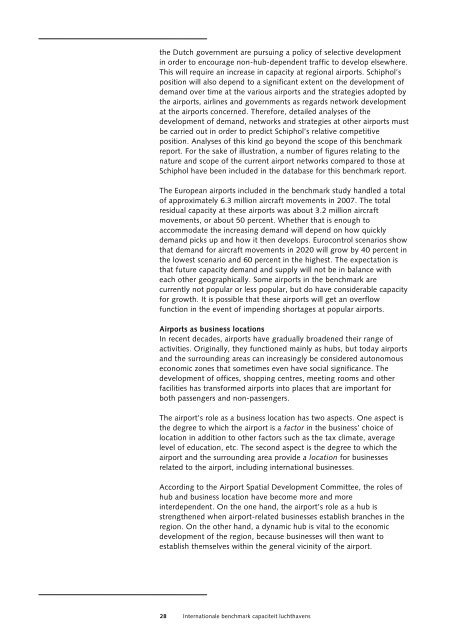Internationale benchmark capaciteit luchthavens - Kennisinstituut ...
Internationale benchmark capaciteit luchthavens - Kennisinstituut ...
Internationale benchmark capaciteit luchthavens - Kennisinstituut ...
You also want an ePaper? Increase the reach of your titles
YUMPU automatically turns print PDFs into web optimized ePapers that Google loves.
the Dutch government are pursuing a policy of selective development<br />
in order to encourage non-hub-dependent traffic to develop elsewhere.<br />
This will require an increase in capacity at regional airports. Schiphol’s<br />
position will also depend to a significant extent on the development of<br />
demand over time at the various airports and the strategies adopted by<br />
the airports, airlines and governments as regards network development<br />
at the airports concerned. Therefore, detailed analyses of the<br />
development of demand, networks and strategies at other airports must<br />
be carried out in order to predict Schiphol’s relative competitive<br />
position. Analyses of this kind go beyond the scope of this <strong>benchmark</strong><br />
report. For the sake of illustration, a number of figures relating to the<br />
nature and scope of the current airport networks compared to those at<br />
Schiphol have been included in the database for this <strong>benchmark</strong> report.<br />
The European airports included in the <strong>benchmark</strong> study handled a total<br />
of approximately 6.3 million aircraft movements in 2007. The total<br />
residual capacity at these airports was about 3.2 million aircraft<br />
movements, or about 50 percent. Whether that is enough to<br />
accommodate the increasing demand will depend on how quickly<br />
demand picks up and how it then develops. Eurocontrol scenarios show<br />
that demand for aircraft movements in 2020 will grow by 40 percent in<br />
the lowest scenario and 60 percent in the highest. The expectation is<br />
that future capacity demand and supply will not be in balance with<br />
each other geographically. Some airports in the <strong>benchmark</strong> are<br />
currently not popular or less popular, but do have considerable capacity<br />
for growth. It is possible that these airports will get an overflow<br />
function in the event of impending shortages at popular airports.<br />
Airports as business locations<br />
In recent decades, airports have gradually broadened their range of<br />
activities. Originally, they functioned mainly as hubs, but today airports<br />
and the surrounding areas can increasingly be considered autonomous<br />
economic zones that sometimes even have social significance. The<br />
development of offices, shopping centres, meeting rooms and other<br />
facilities has transformed airports into places that are important for<br />
both passengers and non-passengers.<br />
The airport’s role as a business location has two aspects. One aspect is<br />
the degree to which the airport is a factor in the business’ choice of<br />
location in addition to other factors such as the tax climate, average<br />
level of education, etc. The second aspect is the degree to which the<br />
airport and the surrounding area provide a location for businesses<br />
related to the airport, including international businesses.<br />
According to the Airport Spatial Development Committee, the roles of<br />
hub and business location have become more and more<br />
interdependent. On the one hand, the airport’s role as a hub is<br />
strengthened when airport-related businesses establish branches in the<br />
region. On the other hand, a dynamic hub is vital to the economic<br />
development of the region, because businesses will then want to<br />
establish themselves within the general vicinity of the airport.<br />
28 <strong>Internationale</strong> <strong>benchmark</strong> <strong>capaciteit</strong> <strong>luchthavens</strong>




